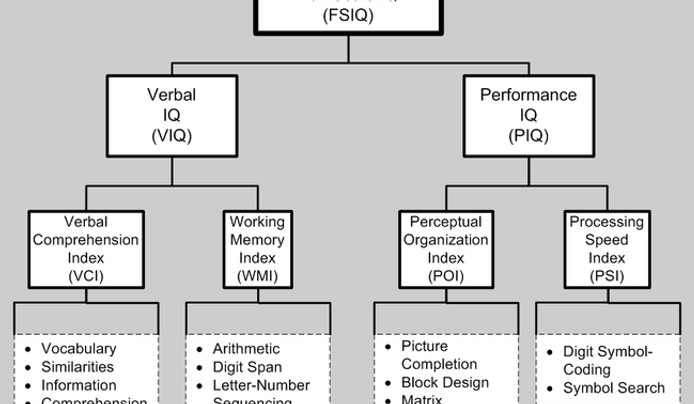A Full Guide to the Wechsler Adult Intelligence Scale (WAIS)
Learn everything about the Wechsler Adult Intelligence Scale—how it works, why it is so popular, and what purposes it can be used for.

The Wechsler Adult Intelligence Scale (WAIS) may not be the first-ever IQ test, but it is the most popular one and also a pioneer in other ways. For instance, it was the WAIS that introduced the current method of measuring IQ used by all standardized IQ tests.
To gain a better understanding of the most widely used IQ test in the world, we’ve consulted our experts and asked them to tell us how the WAIS was developed, what distinguishes it from other IQ tests, and how it benefits society and test takers.
In this article, we will share what they have told us.
Wondering if your IQ is above average? Take the test here!
Take the testKey Takeaways
- The Wechsler Adult Intelligence Scale is defined as a highly reliable IQ test explicitly designed for adults that measures the development of cognitive skills.
- It was originally created by David Wechsler in 1955 as a response to the Stanford-Binet Intelligence Scale and has had several revisions since.
- The WAIS introduced the most common way to measure IQ—by comparing the test taker’s performance to that of their peers.
- As accurate and useful as it may be, the WAIS fails to assess certain kinds of intelligence and isn’t always suitable for neurodivergent individuals and older adults.
What Is the Wechsler Intelligence Scale?

Wechsler adult intelligence scale
Credits: Wikipedia
The Wechsler Adult Intelligence Scale (WAIS) is currently the most popular IQ test. It was designed by American psychologist David Wechsler in 1955 as a response to the shortcomings of the Stanford-Binet Intelligence Scale.
Like Stanford-Binet, the WAIS measures the development of core cognitive skills, such as memory, logical reasoning, deduction, and pattern recognition.
However, it’s far more comprehensive than any other IQ test, consisting of ten core subtests that test four broad components of intelligence and five supplemental tests.
The WAIS is administered exclusively to adults and adolescents over 16. Children younger than 16 and older than six can take the Wechsler Intelligence Scale for Children, which was specifically designed with the younger demographic in mind.
Where to Take the Wechsler IQ Test
Considering its complexity, the only place where you can take the Wechsler IQ test is a professional’s office. A psychologist trained in interpreting IQ tests can administer the WAIS to you and accurately calculate your score from numerous subtests and supplemental tests.
Of course, such a service comes at a cost—usually a couple hundred dollars. Yet, you can find out your accurate IQ score for free, too, especially if you take IQtest.net. The best psychometricians in the field designed our IQ test using some of the latest methods to measure your intelligence quotient.
The History of the Wechsler Adult Intelligence Scale (WAIS)
David Wechsler, one of the most renowned psychologists of the 20th century, didn’t immediately strike gold with his Wechsler Adult Intelligence Scale.
In fact, the first IQ test he developed, the Wechsler-Bellevue Intelligence Scale in 1939, didn’t quite satisfy him, and he substantially improved upon it in 1955.
However, both the Wechsler-Bellevue and the WAIS were developed as a response to the original IQ test, the Stanford-Binet Intelligence Scale.
Namely, Wechsler had many issues with this test, the primary ones being that the tasks were timed and that there was a single score to encompass the entire intelligence.
He also disliked the concept of mental age and believed the Stanford-Binet test was invalid for adults as it was specifically designed for children.
As a result, Wechsler created the original WAIS, which gained enormous popularity in the 1960s. However, this test is no longer used in testing IQ today—instead, the WAIS went through several revisions over the decades.
#1. WAIS-R
The WAIS-R, the first revision of the original Wechsler Adult Intelligence Scale, came in 1981 and increased the number of subtests to six verbal and five performance-related. As a result, this test calculated three scores: a performance IQ, a verbal IQ, and an overall IQ score.
The verbal subtests included Comprehension, Arithmetic, Digit Span, Information, Vocabulary, and Similarities.
On the other hand, performance subtests were Block Design, Picture Arrangement, Object Assembly, Picture Completion, and Digit Symbol.
#2. WAIS-III
The second revision of the scale, the WAIS-III, was developed in 1997, and it increased the number of subtests to seven for verbal and six for performance.
Another subtest, Letter-Number Sequencing, was added to the verbal subtests category, while the performance subtests experienced a more significant change. Namely, Object Assembly was removed and replaced by Matrix Reasoning and Symbol Search.
The scoring remained largely the same, too, except that secondary scores were introduced for verbal comprehension (VCI), working memory (WMI), perceptual organization (POI), and processing speed (PSI).
This was the inception of the four broad components of intelligence used in the latest version of the WAIS.
#3. WAIS-IV
Finally, the newest version of the Wechsler Adult Intelligence Scale, the WAIS-IV, was developed in 2008 and is currently the most widely used IQ test in the world.
This version of the WAIS has four broad intelligence components: the Verbal Comprehension Index, the Perceptual Reasoning Index, the Working Memory Index, and the Processing Speed Index.
All of these are further divided into the following ten core subtests:
- Similarities
- Vocabulary
- Information
- Digit Span
- Arithmetic
- Block Design
- Matrix Reasoning
- Visual Puzzles
- Symbol Search
- Coding
After completing the WAIS-IV, you receive two scores: full-scale IQ, which represents your overall intelligence, and General Ability Index, which combines your scores from the Verbal Comprehension Index and Perceptual Reasoning Index.
In the future, we can expect WAIS-IV to be replaced by WAIS-V—in fact, its development has been in the works since 2020.
WAIS Scoring System

an image of a girl in front of a written white board
Since Wechsler was adamantly against the idea of a single score representing the entirety of a person’s intelligence, his original idea was to create an IQ profile that would highlight strengths and weaknesses and score different aspects of intelligence separately.
After all, according to him, intelligence was too complex of a concept to express in just one number—a sentiment that Alfred Binet actually shared but could never put into practice.
As it turns out, Wechsler couldn’t entirely follow this principle either. Though his test measures different aspects of intelligence separately, even the earlier editions of the WAIS combined all results into a single score.
However, Wechsler did manage to put one of his principles into practice. He disliked the idea of mental age used on the Stanford-Binet test, so the Wechsler Adult Intelligence Scale’s scoring system relies on comparing performance to that of the test taker’s peer group.
Nowadays, this method is by far the most widespread of all psychometric approaches, used even by the Stanford-Binet Intelligence Scale.
WAIS vs. Stanford-Binet Test
The WAIS may be the most popular IQ test, but it’s certainly not the only available one. It has tough competition in Raven’s Progressive Matrices, the Cattell Culture Fair Intelligence Test, and, of course, the Stanford-Binet Intelligence Scale.
Since the Wechsler Adult Intelligence Scale and the Stanford-Binet Intelligence Scale are often seen as direct competitors, we’ll take a closer look at their differences and similarities.
Stanford-Binet Intelligence Scale :
- Published in 1916
- Developed to help determine the IQs of school children
- Appropriate for all age ranges, although the original was made for testing children
- Emphasizes timed tasks
- Provides a single IQ score
Wechsler Adult Intelligence Scale :
- Published in 1955
- Developed as a response to Stanford-Binet
- Exclusively made for adults and older adolescents
- Contains a few timed subtests
- Provides two scores: full-scale IQ and the General Ability Index
WAIS Test Benefits
The WAIS is often considered reliable, accurate, and a useful clinical tool for detecting disabilities and brain injuries.
Below, we will examine these benefits in more detail.
#1. Reliability
The Wechsler Adult Intelligence Scale is backed up by decades of research conducted by the best psychologists and psychometricians in the field. On top of that, it has gone through several revisions and has been used on countless individuals in over 60 years of its existence.
In other words, it’s hard to find a more reliable IQ test among the available ones. That’s further confirmed by several studies that measured its test-retest reliability (consistency in results over a period of time) and concluded that it was exceptionally high.
#2. Accuracy
Considering that it comes with ten core subtests measuring different aspects of intelligence, it’s clear that the WAIS takes accuracy very seriously. Its goal is to provide an in-depth overview of your cognition, and it undoubtedly succeeds in accomplishing this.
In addition, the WAIS has been dubbed one of the most well-designed IQ tests by numerous psychologists, and its widespread use is also a testament to its quality.
#3. Useful Clinical Tool
The WAIS can be used in clinical settings, particularly when detecting learning and cognitive disabilities in children and assessing their severity. For instance, a particularly low score on this IQ test may indicate a problem with cognition that can seriously affect a person’s life.
Moreover, IQ tests like the WAIS can sometimes be used to assess traumatic brain injury. Though they are rarely used for actual diagnosis, they can provide information about the severity of brain damage and the areas of cognition it affects in particular.
Then, clinicians may have an easier time deciding what treatment approach to take.
Limitations of the WAIS Test

Wechsler adult intelligence scale limitations
Although the WAIS is among the best currently available IQ tests, it still has a few shortcomings that its future versions might be able to address. Namely, it doesn’t assess intelligence in its entirety and isn’t always suitable for neurodivergent and older adults.
Let’s explore these limitations in more detail.
#1. Doesn’t Assess Non-Academic Skills
As we’ve seen above, the WAIS paints a rather comprehensive picture of intelligence, as it assesses its various aspects through 10 subtests and combines the results to get the final overarching score.
However, no matter how comprehensive it may be, it’s simply not comprehensive enough to encompass human intelligence in its entirety. Namely, there are still facets that can’t be captured using the WAIS or any other currently available IQ test.
Emotional and interpersonal intelligence are often listed as two crucial examples. These two types of intelligence are vital in our everyday lives, yet IQ tests can’t really account for them. As long as that’s the case, all IQ tests, including the WAIS, will be somewhat flawed.
#2. Can’t Accurately Calculate IQ for Neurodivergent Adults
People on the autism spectrum, those with ADHD, and other neurodivergent adults might not have much use of the WAIS, as it can’t accurately calculate IQ scores when there are significant discrepancies between different subtests.
For instance, if you perform exceptionally well on the verbal parts of the test but score drastically lower on the ones related to perception or numerical processing, your final score likely won’t be determined.
While this isn’t usually a problem with neurotypical people, whose general performance on most subtests tends to even out, neurodivergent people may excel at specific parts of the test and completely fail other ones.
As a result, they could get a score that doesn’t accurately represent their intelligence or not get one at all.
#3. May Not Be Suitable for Older Adults
The current edition of the WAIS was standardized using a sample of people in age groups ranging from 16 to 90. In other words, we have data about the test’s accuracy and performance in these age groups, but not for those older than 90.
As a result, it’s hard to say whether the WAIS-IV is suitable for adults over the age of 90. While there is no reason to believe it wouldn’t be, there’s also no scientific evidence to prove that it is.

Take this free test to get accurate results
Discover your IQ score by taking our online IQ test and embark on your self-development journey today!
Start the test nowFinal Thoughts
The Wechsler Adult Intelligence Scale has certainly made waves in the branch of psychology that deals with intelligence, setting a standard for what an IQ test should look like.
Of course, it is far from perfect, but despite its limitations, it paints a comprehensive picture of one’s intelligence and manages to impress with its reliability, accuracy, and widespread use.
As a result, this test can be encountered in various settings, including schools, workplaces, clinics, psychologists’ and psychiatrists’ offices, and other places that might require you to test your intelligence.



